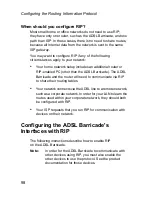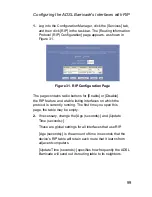
Configuring DNS Server Addresses
86
•
Dynamically from a DHCP pool:
You can configure the DHCP Server feature on the ADSL
Barricade and create an address pool that specifies the DNS
addresses to be distributed to the PCs. Refer to Configuring
Dynamic Host Configuration Protocol for instructions on
creating DHCP address pools.
In either case, you can specify the actual addresses of the
ISP's DNS servers (on the PC or in the DHCP pool), or you can
specify the address of the LAN port on the ADSL Barricade (e.g.
192.168.1.1). When you specify the LAN port IP addresses, the
device performs DNS relay, as described in the following section.
Note:
If you specify the actual DNS addresses on the PCs or
in the DHCP pool, the DNS relay feature is not used.
Configuring DNS Relay
When you specify the ADSL Barricade's LAN port IP addresses
as the DNS addresses, then the device automatically performs
DNS relay; i.e., because the device itself is not a DNS server, it
forwards domain name lookup requests it receives from the LAN
PCs to a DNS server at the ISP. It then relays the DNS server's
response to the PC.
When performing DNS relay, the ADSL Barricade must maintain
the IP addresses of the DNS servers it contacts. It can learn
these addresses in either or both of the following ways:
•
Learned through PPP:
If the device uses a PPP connection to the ISP, the primary
and secondary DNS addresses can be learned via the PPP
protocol. To use this method, the [Use DNS] checkbox
must be selected in the [PPP Interface Properties]. (See
Configuring PPP Interfaces on page 109 for instructions on
















































